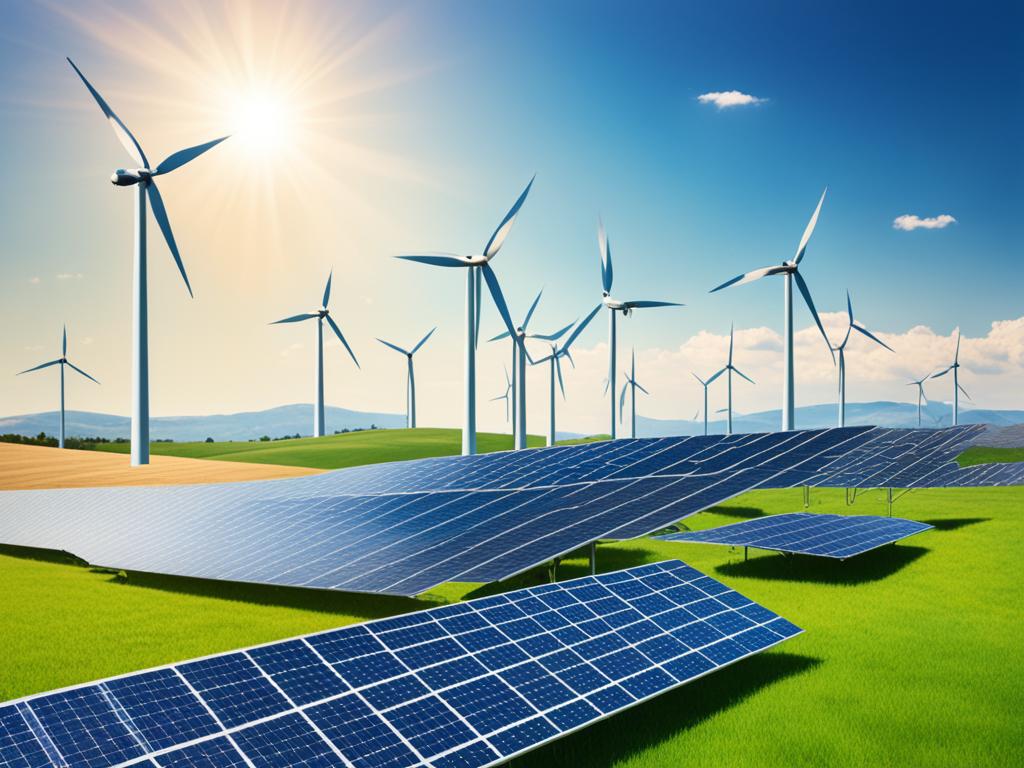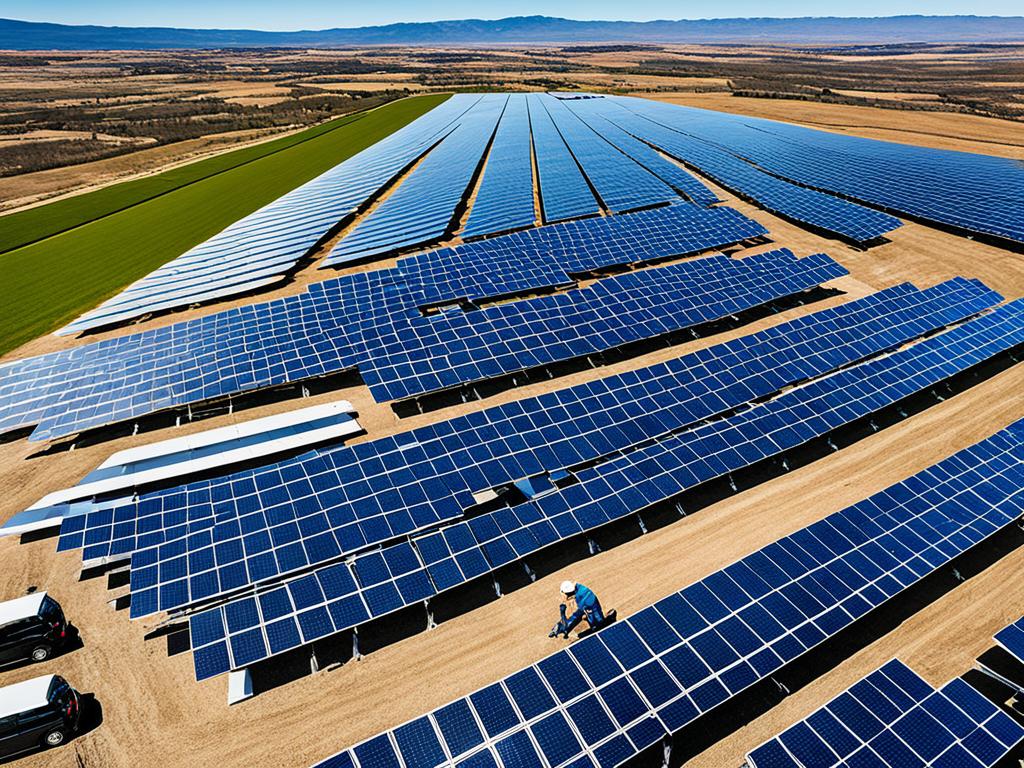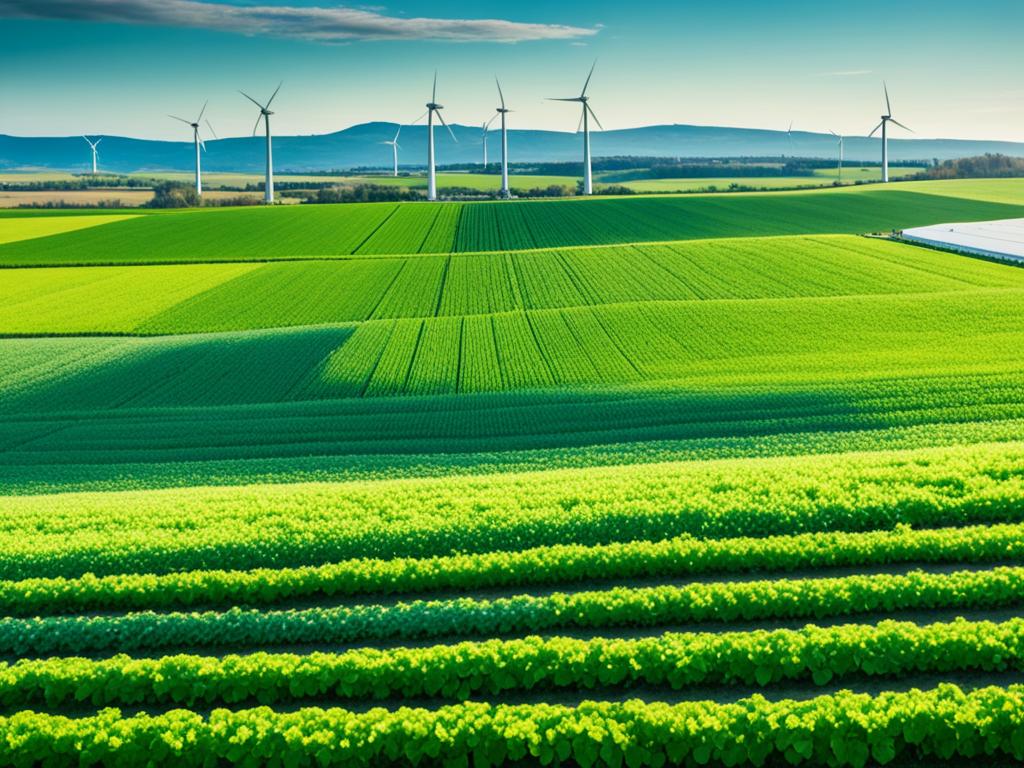Today, we face big worries about our environment. We must move towards a greener, more lasting future. Luckily, renewable energy offers us a way out. It comes from sources that don’t run out, like sunlight and wind. This kind of energy is clean and will stay around for us to use.
More and more, we hear about the ESG values. These focus on making a positive impact on the world. Using renewable energy is one way to do this. It’s good for the planet and for business. Big names like Google, Microsoft, and Tesla are going green. They are investing a lot in renewable energy to cut down on pollution.
We, too, can help the move to renewable energy. We can pick a green energy supplier and put up solar panels. We can also support businesses that use clean energy. By asking for more green energy rules, together we can make a real difference.
Key Takeaways
- Renewable energy sources, such as solar, wind, and hydropower, offer a clean and sustainable alternative to fossil fuels.
- Leading companies are investing in renewable energy projects to reduce their carbon footprint and align with ESG principles.
- Individuals can support the transition to renewable energy through personal choices and advocacy.
- Renewable energy costs have significantly fallen, making it more accessible and competitive.
- Renewable energy solutions can contribute to sustainable development and energy independence.
Renewable Energy: Harnessing Nature’s Power
The move to a sustainable energy future is picking up steam. Renewable sources are now key players. Solar energy, coming from the sun, stands out as a top choice. It’s plentiful and easy to get to.
Today, solar panels change sunlight into electricity. And there are systems that use the sun to warm water or air. This energy is getting cheaper, thanks to technology. It’s now a big rival in making power, offering clean and steady energy.
Solar Energy: Tapping into the Sun’s Abundance
The sun’s power is huge. Places with lots of sunshine can make the most of it. As technology gets better and cheaper, solar is a stronger choice. It’s great for places far from power lines.
Off-grid solar helps whole communities. It lets kids study at night and improves health care. Plus, it helps economies grow. Using solar can make life better and fight poverty.
Wind Energy: Capturing the Force of the Wind
Using wind through turbines is a big deal in renewable energy. Wind farms are built on land and in the sea. They power us without pollution or using up water.
Even though wind comes and goes, we’re getting better at saving its power. Wind power helps lots of people get jobs. It also boosts local economies, especially in growing places.
| Renewable Energy Source | Cost Reduction (2010-2020) |
|---|---|
| Solar Energy | 85% |
| Onshore Wind Energy | 56% |
| Offshore Wind Energy | 48% |
Solar, onshore wind, and offshore wind have all gotten much cheaper. In the last 10 years, their costs dropped a lot. This makes them better choices for energy, for everyone.
Why Renewable Energy Matters
Renewable energy sources offer a great way to fight climate change. They help cut pollution and improve energy independence. By using the sun, wind, water, and the Earth’s heat, we can move to cleaner, sustainable energy use.
Environmental Benefits of Renewable Energy
Renewable energies don’t make much greenhouse gas or pollution. This helps keep the environment safe. Fossil fuels create most of the world’s greenhouse gases. They also make almost all the carbon dioxide. Switching to renewable energy is key to fighting climate change.
Economic Advantages of Clean Energy
Choosing renewable energy is good for the wallet too. It lowers energy prices, creates jobs, and helps local economies. Electricity from the sun has become much cheaper. It’s dropped by 85 percent since 2010. The costs of wind power have also gone down by almost half. This makes renewable energy a smart and affordable choice.
Promoting Energy Independence
Renewable energy means we don’t rely on fossil fuels as much. It makes us more resilient and secure. This is especially good for countries that import a lot of their energy. Using renewable energy can make them less dependent on other countries. It strengthens their own energy sources.

Renewable Energy Solutions: A Path to a Sustainable Future
Renewable energy is becoming a beacon of hope worldwide. It has allowed many countries, especially in the developing world, to start using solar and wind power. This move reduces harmful emissions and ensures energy security. Solar power turns sunlight into electricity and heat, making it perfect for sunny places. Wind power, on the other hand, uses wind’s force to spin turbines, creating electricity. This method is a great fit for many developing countries.
Adopting renewable energy means these developing areas can produce their own power. They won’t need to rely so much on expensive fossil fuels. This shift also boosts local economies, creating jobs and driving economic growth. Moving to renewable energy is not just a smart choice; it’s essential for our planet and future.
| Company | Renewable Energy Target |
|---|---|
| Operate on 100% renewable energy by 2030 | |
| Microsoft | Be carbon negative by 2030 |
In the last few years, the cost of renewable energy has dropped significantly. This affordability makes it a practical choice for many companies. Investing in renewables can save businesses money and improve their image. What’s more, many electric companies now offer wind and solar power choices, letting homeowners join the movement towards sustainability.
Pushing for renewable energy policies can speed up the use of clean energy. Worldwide initiatives and policies are making it easier to choose renewable power. The renewable energy industry is good for the planet and also boosts economies. It’s a key part of building a sustainable future.
Solar Power: Lighting the Way Forward
Solar energy comes from the sun’s rays, offering a clean path to generating power and heat. The sun is a top-notch source of renewable energy, especially for countries with a lot of sunshine. It’s a game-changer for those aiming to use clean, green electricity.
Solar panels and cells are getting more affordable, especially in the sunshine-rich parts of the world. These places can now light up even the most remote areas with solar power. This change is making a huge difference, helping people study at night, making healthcare better, and creating job chances.
This shift to solar power is not just about saving money. It’s also making life better and helping to fight poverty. Countries are moving away from using up Earth’s non-renewable resources. Solar energy is leading to brighter futures all around.

The Jammu Power Distribution Corporation Limited (JPDCL) is making big moves to switch to more solar power. Their plan will roll out between FY 2023-24 and FY 2025-26. They’re adding solar power through smart partnerships to create lots of clean electricity. This will help meet the area’s growing need for power.
This shift to solar power in Jammu is about more than just being kind to the planet. It’s also about making the energy supply more secure by not depending too much on one source. Using solar power will also open up new jobs and businesses in solar technology and related areas. This will boost the economy and make the region even better.
Wind Energy: A Breath of Fresh Air
Wind energy uses the power of the wind to turn turbines, producing electricity. It’s a green revolution led by China and India. Yet, it’s an excellent option for clean energy around the world.
These wind turbines give countries a way to make their own clean power. They work well both on land and at sea. This makes wind energy a key player in the fight against climate change.
Onshore Wind Farms
Wind turbines on land help make our energy cleaner. They reduce our carbon footprint, covering about 1% of the Earth’s land area. This shows how much space is needed for turbines that bring us clean power.
The wind industry spends a lot on new technology, over $20 billion every year. This money helps improve wind energy and make it more efficient. It shows a big focus on finding better ways to use the wind.
Offshore Wind Turbines
Offshore wind farms take advantage of windy coastal areas. This means they produce a lot of electricity without polluting. They’ve also created many jobs around the world. People work in making, building, and looking after these wind turbines.
Technological Advancements in Wind Power
Wind turbines have gotten a lot better over the years. They are now 47% more efficient than they used to be. And in the last five years, the cost of using wind energy has dropped by 30%. This means wind power is more affordable than ever.
Using wind energy has also helped cut billions of tons of CO2 every year. This is a big win in the fight against climate change. Wind power is making a real difference for our planet.
Hydroelectric Power: Harnessing the Flow of Water
Hydropower comes from water’s natural movement. It’s a key source of renewable energy. Hydroelectric dams use flowing water to create electricity. This system ensures a stable power source.
But building big dams can harm the environment. It can change natural habitats and cause soil buildup. So, finding eco-friendly ways to use water energy is crucial.
Sustainable Hydropower Development
The hydropower industry works to be Earth-friendly. They build plants that don’t harm wildlife and help water stay clean. They also manage water-flow to reduce harm to nature.
These steps protect our planet while still making power. It’s about finding a balance.
Pumped-Storage Hydroelectricity
Imagine using water to store energy. That’s what pumped-storage hydroelectricity does. It stores extra power by pumping water uphill. Then, when needed, it lets the water flow down to make electricity.
This method makes power reliable, even when the wind doesn’t blow or the sun doesn’t shine.
| Hydropower Statistics | Value |
|---|---|
| Hydropower’s share of renewable electricity generation | 27% |
| Hydropower’s share of total electricity generation | 6% |
| Hydropower’s share of primary energy | 1% |
| Capacity of the Sam Rayburn Hydroelectric Power Plant | 50 megawatts |
| Capacity of the Fort Worth District’s hydroelectric power plants | 90 megawatts |
| Homes that can be powered by the Fort Worth District’s hydroelectric plants | Over 100,000 |
| Lifespan of hydropower plants | Often exceeds 50 years |
As the world aims for clean energy, hydropower is key. It offers steady power without adding much to pollution. It’s a big help in keeping our planet green and bright.
Geothermal Energy: Tapping into the Earth’s Heat
Geothermal energy comes from the Earth’s inner heat. It’s great for making electricity, heating, and cooling. But, it needs the right ground conditions to work well. Some places have more geothermal energy than others.
Geothermal Power Plants
Geothermal power plants turn the Earth’s heat into power. They reach deep into the ground to find hot water and steam. These power plants can run well in areas where the Earth’s heat is close to the surface.
There are different types of power plants, like binary cycle and flash steam plants. They’re efficient at making electricity from geothermal heat.
Geothermal Heat Pumps
Geothermal heat pumps are a greener way to heat and cool buildings. They use the Earth’s stable temperature to work. This technology helps lower energy use and emissions.
With better designs and using natural coolants, these systems are even more effective today.
| Geothermal Energy Advantages | Geothermal Energy Challenges |
|---|---|
|
|
Geothermal energy is good for the planet and provides lasting power. But, not everywhere can use it easily. It can be expensive to set up.
Yet, as tech gets better and with help from governments, geothermal energy is finding its place in the world. It’s becoming a key player in reducing pollution.
Bioenergy: Fueling the Future
Biomass energy uses materials like wood and farm waste to make power. This power can be in the form of heat, electricity, or biofuels. It is the top source of renewable energy around the world, making up 9.5% of energy and 70% of renewable energy. This shows how important it is for our planet’s future.
Biofuels
Biofuels are made from plants; examples include ethanol and biodiesel. They are a green choice for our cars and trucks, cutting down on pollution. Known as 2nd and 3rd generation biofuels, they come from things that are not food. This makes them a good step for clean energy. Biofuels help make our transport greener by making vehicles less polluting.
Biomass Combustion
Biomass combustion means burning natural materials to make heat and electricity. It is done using biopower technologies. These technologies help make the power we need more flexible and reliable. They can also make useful products like plastic and chemicals, which add value and make things more efficient.
Biogas Production
Biogas is made by breaking down waste naturally, without air, to get gas with methane in it. This gas is rich in energy and is a clean choice. Bioenergy like this can help fight climate change by aiming for zero net emissions by 2050. But it’s vital to manage natural materials without harming the environment or taking away from food supplies.

| Bioenergy Metric | Value |
|---|---|
| Bioenergy’s contribution compared to solar PV and wind in 2017 | 4 times greater |
| Projected bioenergy’s share of renewable energy production growth from 2018-2023 | 30% |
| Bioenergy’s share of total renewable energy consumption in 2017 | 50% |
| Bioenergy’s projected share of electricity production in 2023 | 3% |
| Bioenergy’s projected share of transport energy demand in 2023 | 4% |
| Annual growth rate of liquid biofuel production for transportation from 2010-2016 | 4% |
| Average annual growth rate of bioenergy electricity capacity from 2010-2016 | 6.5% |
| Projected biomass share of primary energy in 2050 (median scenario) | 26% |
| Potential bioenergy production range (EJ/year) | 1,000 |
Overcoming Challenges in Renewable Energy Adoption
Renewable energy has huge potential but faces challenges in widespread use. Intermittency, grid integration, energy storage, and infrastructure needs are big roadblocks. We must tackle these to speed up the shift to renewable energy.
Energy Storage Solutions
Solar and wind power come and go, making energy storage essential for a stable grid. Better batteries, pumped-storage, and thermal storage are key. They help deal with the stop-and-start nature of renewables, allowing them to join the grid more smoothly.
Grid Integration and Transmission
Mixing renewable energy with our current grid is tough. But, new software, transmission tech, and smart grids can make it work better. They help handle the variable nature of renewables, making our energy system stronger and more reliable.
Policy and Regulatory Frameworks
Good policy frameworks and regulatory environments are vital for renewable energy’s success. Bad or changing rules, hard permits, and few incentives block projects. Talking to leaders and pushing for better policies is crucial for those involved in renewable energy.
A Sustainable Future with Renewable Energy
Moving to renewable energy is a must for our planet and coming generations. New technologies and lower costs push this change. With more research, support from governments, and the public, we can make this shift quickly.
Driving Innovation and Technological Advancements
Solar panels, wind turbines, and better ways to store energy are changing how we use power. Thanks to these advances, renewable energy is now more affordable. Companies like Tesla and big tech names aim to use only renewable power, showing their strong commitment.
Collaborative Efforts and Public Awareness
Working together is key in reaching a world powered by renewable sources. Pushing for policies that support renewable energy and choosing green businesses can help a lot. It speeds up the switch to clean energy.
Seeing more systems that generate power locally, and efforts from communities, can make us more resilient and less dependent on old, harmful fuels. Plus, when people learn more and take actions for the planet, it helps sustainable energy grow in the market.
Source Links
- https://medium.com/@anandv_62921/renewable-energy-and-esg-a-path-to-a-sustainable-future-19a75d11440f
- https://blue.star-board.com/news/empowering-developing-nations-through-renewable-energy-a-path-to-a-sustainable-future/
- https://www.linkedin.com/pulse/renewable-energy-solutions-sustainable-path-forward-sujeesh-kumar-vs-nlw7c
- https://www.un.org/en/climatechange/raising-ambition/renewable-energy
- https://4ewave.com/2020/07/24/renewable-energy-path-to-future/
- https://www.linkedin.com/pulse/power-renewable-energy-exploring-sustainable-victor-obobolo
- https://www.energy.gov/eere/why-clean-energy-matters
- https://medium.com/@princesamiullah28/solar-panels-lighting-the-path-to-sustainable-energy-90bdb7f61048
- https://freyrenergy.com/lighting-up-your-home-with-solar-power-system-a-sustainable-path-to-the-future/
- https://solarquarter.com/2024/04/09/illuminating-a-sustainable-path-jpdcls-solar-power-strategy-lights-the-way-forward/
- https://www.linkedin.com/pulse/breath-fresh-air-wind-energys-digital-transformation-noever-castelos-s4yyc?utm_source=rss&utm_campaign=articles_sitemaps
- https://energival.ma/wind-energy/wind-energy-a-breath-of-fresh-air-for-sustainable-power/
- https://www.greencitytimes.com/mind-blowing-facts-about-wind-energy/
- https://www.army.mil/article/271087/hydropower_harnessing_the_power_of_water_for_a_sustainable_future
- https://www.energy.gov/eere/water/benefits-hydropower
- https://www.linkedin.com/pulse/geothermal-energy-tapping-earths-kgdr-consultants-inc
- https://www.graygroupintl.com/blog/geothermal-energy
- https://www.equans.com/news/geothermal-energy-unlocking-earths-hidden-heat-build-sustainable-future
- https://www.an.shimadzu.com/FuellingaSustainableFutureSolutionsForBiofuelsAnalysis.html
- https://www.energy.gov/eere/bioenergy/bioenergy-basics
- https://www.ncbi.nlm.nih.gov/pmc/articles/PMC6973137/
- https://www.linkedin.com/pulse/breaking-barriers-overcoming-challenges-renewable-energy-manohar-qegbf?trk=public_post_main-feed-card_feed-article-content
- https://www.linkedin.com/pulse/overcoming-challenges-renewable-energy-deployment-from-chaudhary


